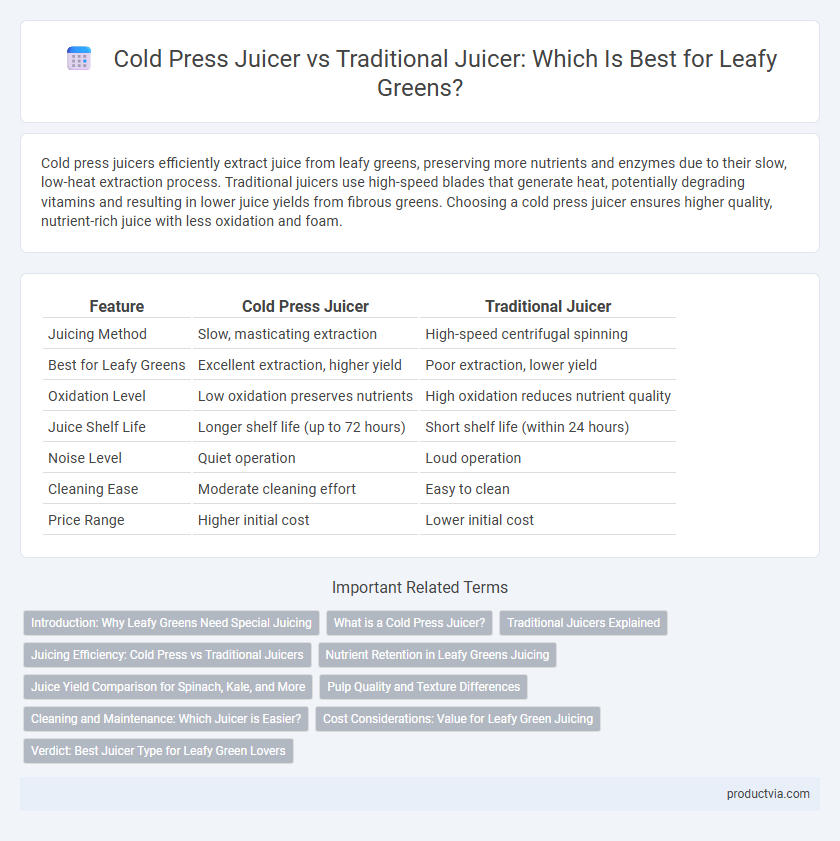Cold press juicers efficiently extract juice from leafy greens, preserving more nutrients and enzymes due to their slow, low-heat extraction process. Traditional juicers use high-speed blades that generate heat, potentially degrading vitamins and resulting in lower juice yields from fibrous greens. Choosing a cold press juicer ensures higher quality, nutrient-rich juice with less oxidation and foam.
Table of Comparison
| Feature | Cold Press Juicer | Traditional Juicer |
|---|---|---|
| Juicing Method | Slow, masticating extraction | High-speed centrifugal spinning |
| Best for Leafy Greens | Excellent extraction, higher yield | Poor extraction, lower yield |
| Oxidation Level | Low oxidation preserves nutrients | High oxidation reduces nutrient quality |
| Juice Shelf Life | Longer shelf life (up to 72 hours) | Short shelf life (within 24 hours) |
| Noise Level | Quiet operation | Loud operation |
| Cleaning Ease | Moderate cleaning effort | Easy to clean |
| Price Range | Higher initial cost | Lower initial cost |
Introduction: Why Leafy Greens Need Special Juicing
Leafy greens contain tough cellulose and high water content, making them difficult to juice efficiently with traditional juicers that use high-speed blades. Cold press juicers use slow, gentle crushing and pressing methods to extract maximum nutrients and enzymes from leafy greens without oxidation. This process preserves vital vitamins, antioxidants, and chlorophyll, ensuring a fresher, more nutrient-dense juice.
What is a Cold Press Juicer?
A cold press juicer, also known as a masticating juicer, uses a slow, crushing mechanism to extract juice from leafy greens, preserving nutrients and enzymes more effectively than traditional centrifugal juicers. This method minimizes heat generation and oxidation, resulting in higher juice yield and increased nutrient retention. Cold press juicers excel in processing fibrous greens like kale, spinach, and wheatgrass, delivering smoother, nutrient-rich juice compared to the pulpier output from traditional juicers.
Traditional Juicers Explained
Traditional juicers, often referred to as centrifugal juicers, use high-speed spinning blades to shred leafy greens and extract juice quickly, but they tend to produce lower juice yields and more foam compared to cold press juicers. These juicers generate heat during extraction, which can degrade some nutrients and enzymes in leafy greens. Despite these drawbacks, traditional juicers remain popular for their fast operation and affordability.
Juicing Efficiency: Cold Press vs Traditional Juicers
Cold press juicers extract juice by slowly crushing and pressing leafy greens, preserving more nutrients and yielding higher juice output compared to traditional centrifugal juicers that use high-speed spinning blades. The slow extraction process of cold press juicers minimizes heat and oxidation, resulting in firmer pulp and more efficient juice separation. Traditional juicers often lose valuable vitamins and enzymes due to heat and aeration, producing lower juicing efficiency for leafy greens.
Nutrient Retention in Leafy Greens Juicing
Cold press juicers extract juice by slowly crushing leafy greens, preserving high levels of vitamins, antioxidants, and enzymes compared to traditional juicers that use high-speed blades generating heat and oxidation. This method minimizes nutrient degradation, ensuring maximum retention of chlorophyll and essential micronutrients such as vitamin K, vitamin C, and folate. As a result, cold press juicing delivers more nutrient-dense juice ideal for leafy greens like spinach, kale, and wheatgrass.
Juice Yield Comparison for Spinach, Kale, and More
Cold press juicers extract significantly higher juice yield from leafy greens like spinach and kale compared to traditional centrifugal juicers, which often leave pulp wetter and nutrient-rich liquid behind. The slow, masticating process of cold press juicers preserves more vitamins and enzymes by minimizing heat and oxidation, enhancing both juice volume and quality. Studies show cold press juicers can yield up to 30-40% more juice from leafy greens, making them ideal for nutrient-dense greens.
Pulp Quality and Texture Differences
Cold press juicers extract juice by slowly crushing leafy greens, resulting in a higher quality pulp with finer texture and less moisture, which retains more nutrients and fiber. Traditional juicers use high-speed spinning blades that often produce wetter, coarser pulp with more foam and heat, leading to nutrient degradation. The pulp from cold press juicers is visibly drier and more compact, enhancing juice yield and texture for leafy greens like spinach and kale.
Cleaning and Maintenance: Which Juicer is Easier?
Cold press juicers are easier to clean and maintain when processing leafy greens because they have fewer parts and use slow pressing, which reduces pulp residue buildup. Traditional juicers often require more thorough cleaning due to multiple components and fast-spinning blades that cause more froth and fiber clogs. Choosing a cold press juicer minimizes cleaning time and keeps maintenance simpler for frequent leafy green juicing.
Cost Considerations: Value for Leafy Green Juicing
Cold press juicers generally have a higher upfront cost compared to traditional juicers, but their efficient extraction process yields more juice from leafy greens, providing better long-term value. Traditional juicers often require additional preparation and produce less juice, leading to more frequent purchases of greens and higher ongoing expenses. Investing in a cold press juicer maximizes nutrient retention and juice yield per dollar spent, making it more cost-effective for regular consumption of leafy greens.
Verdict: Best Juicer Type for Leafy Green Lovers
Cold press juicers excel at extracting higher nutrient content and yield from leafy greens compared to traditional centrifugal juicers, which often produce foam and heat that degrade delicate vitamins. The slow masticating process minimizes oxidation, preserving enzymes and antioxidants crucial for health benefits. For leafy green enthusiasts seeking maximum nutrition and juice quality, cold press juicers represent the best investment.
Cold press juicer vs traditional juicer for leafy greens Infographic

 productvia.com
productvia.com